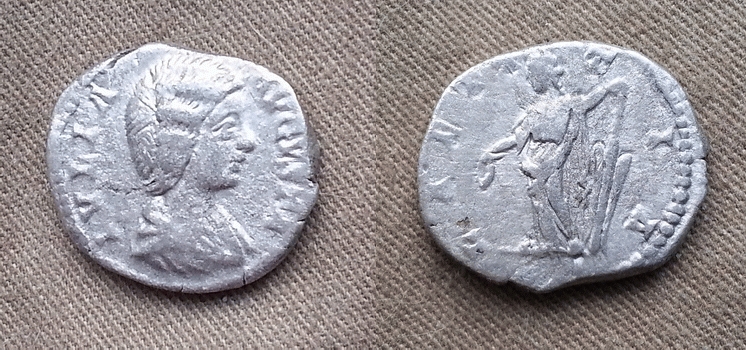
Julia Domna, AE24 of Stobi, Macedonia.
IVLIA AVGVSTA, draped bust right.
MVNICI STOBENS, Nike advancing right, holding wreath
and palm.
(I couldn't find a listing, but it is very similar
to Varbanov 3922 and Josifovski 202.)

Julia Domna Denarius Rome mint: AD 196-211
IVLIA AVGVSTA Draped bust right, hair in bun behind
LAETITIA, Laetitia standing, head left, holding patera
and rudder
RIC 561, RSC 101.
|
|
Julia Domna, also known as Julia Domma, (Latin: Iulia Domna; 170 AD – 217
AD) was a member of the Severan dynasty of the Roman Empire. Empress
and wife of Roman Emperor Lucius Septimius Severus and mother of Emperors
Geta and Caracalla, Julia was famous for her prodigious learning as well
as her extraordinary political influence.
Family background:
Julia was from a family of the city of Emesa (known today as Homs), Syria.
She was the youngest daughter of the high-priest Gaius Julius Bassianus
and her eldest sister was Julia Maesa. Her ancestors were Priest
Kings of the famous temple of Elagabalus. The family had enormous
wealth and was promoted to Roman senatorial aristocracy. Before her
marriage, Julia inherited the estate of her paternal great-uncle Julius
Agrippa, a former leading Centurion.
Reign:
In the late 180s, Julia married future Emperor Septimius Severus, usually
considered to be of Punic background. The marriage proved to be a
happy one, and Severus cherished his wife and her political opinions.
She was very wellread and keen on philosophy. They had two sons,
Lucius Septimius Bassianus (Caracalla) in 188 and Publius Septimius Geta
in 189. Because of her love of philosophy, Julia protected philosophers
and helped philosophy to flourish in Rome.
Civil War:
When Severus became emperor in 193 (known as "Year of the Five Emperors"),
he had a civil war waiting for him, against rivals such as Pescennius Niger
and Clodius Albinus. Julia accompanied him in his campaigns in the
East, an uncommon event at a time when women were expected to wait in Rome
for their husbands. Nevertheless, she remained with the emperor and
among the several proofs of affection and favour are the minting of coins
with her portrait and the title mater castrorum (mother of the camp).
Controversy and transition of power:
As empress, Julia was often involved in intrigues and had plenty of political
enemies, who accused her of treason and adultery. None of these accusations
was proven. Severus continued to favour his wife and insisted on
her company in the campaign against the Britons that started in 208.
When Severus died in 211 in Eboracum (York), Julia became the mediator
between their two sons, Caracalla and Geta, who were to rule as joint emperors,
according to their father's wishes expressed in his will. The two
young men were never fond of each other and quarrelled frequently.
Geta was murdered by Caracalla's soldiers in the same year.
Caracalla was now sole emperor, but his relations with his mother were
difficult, as attested by several sources, probably because of his involvement
in Geta's murder. Nevertheless, Julia accompanied Caracalla in his
campaign against the Parthian empire in 217.
During this trip, Caracalla was assassinated and succeeded (briefly) by
Macrinus. Julia chose to commit suicide after hearing about the rebellion,
perhaps a decision hastened by the fact that she was suffering from breast
cancer. Her body was brought to Rome and placed in the Sepulcrum
C. et L. Caesaris (perhaps a separate chamber in the Mausoleum of Augustus).
Later, however, both her bones and those of Geta were transferred by her
sister Julia Maesa to the Mausoleum of Hadrian. She was later deified.
Apollonius:
If it were not for Julia, there would have survived little information
about the philosopher Apollonius of Tyana. It was at the behest of
Julia that Philostratus wrote his now famous Life of Apollonius of Tyana.
Julia is thought to have died before Philostratus could finish his work
of eight volumes.
Information was taken from Wikipedia, the free encyclopedia
at this URL:
https://en.wikipedia.org/wiki/Julia_Domna
|